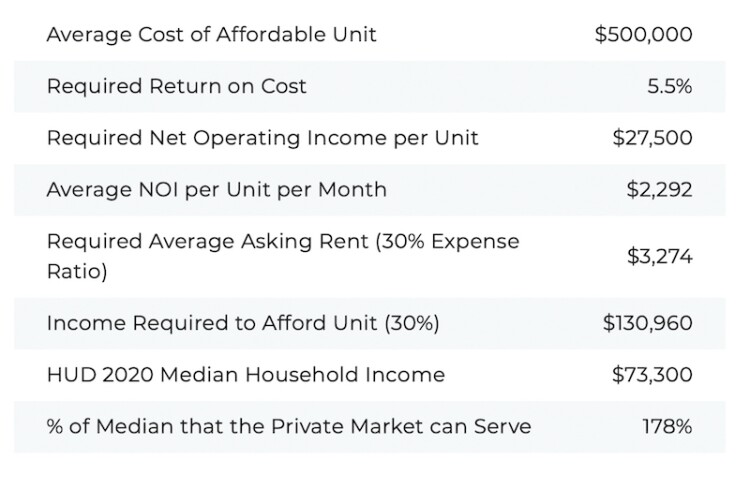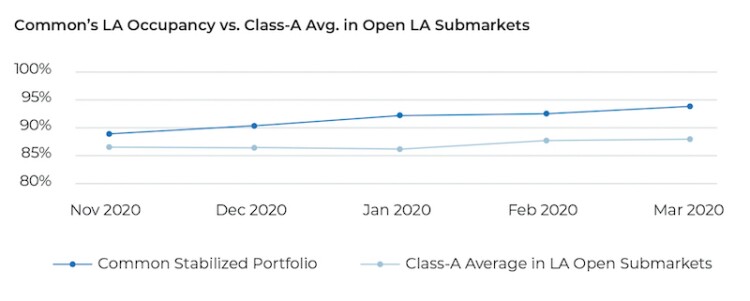The institutional investment world loves to take headline news and extrapolate it into their real estate investment strategies. One of my favorite examples was after 9/11 when Research Directors predicted that companies and residents would flee New York City. That lasted about nine months, and surely some companies and residents fled, however the following twenty years resulted in massive value growth in New York City real estate and the dire predictions of its future proved unfounded.
A similar thought process is impacting high density residential today in major urban markets, such as small units and co-living. The general theory is that the pandemic has created a fear of living in urban environments and dense spaces and that a large segment of the urban population has fled for the suburbs or small cities never to return. I personally believe that this is highly unlikely. These times are, without question, very dark days for dense cities like San Francisco, which frankly looks post-apocalyptic. However, I believe that great urban centers will see a phenomenal rebirth once millions of 20-somethings come bursting out of their parents’ basements. If the recent Spring Break activities in South Beach are any indicator, I predict we will soon see a level of hedonism not seen since the 60’s.
Need of Dense Urban Housing
The reality is that dense affordable housing is a critical component of the housing stock and always has been. Sadly, the perception that dense urban housing is in some way substandard has impacted zoning and housing policy for decades. Many housing economists, myself included, believe that this counter-intuitive regulatory environment has perpetrated homelessness and housing affordability in most major markets.
I noticed this fundamental disconnect back in the 80’s in New York City as a Metropolitan Studies major at New York University. About this time, New York City was witnessing the mass destruction of Single Room Occupancy (SRO) units through demolition and conversion to Class A units. The best information available estimates that there were over 200,000 SRO units in New York City after World War II. Today the inventory is closer to 40,000. In 1987, New York City passed the Quality Housing Program which prohibited the development of units less than 400 square feet. This has led to almost half a century of housing production in New York City which was not available to moderate income tenants without substantial governmental assistance.
An Example: Housing Affordability in Los Angeles
The math is clear. It is virtually impossible to supply new housing to largest segment of the population (those earning less than 150% of median income) in high cost, dense urban environments like New York, San Francisco and LA. This is the segment of the population which needs it the most. The cost of housing production in Los Angeles is substantially less than New York City and San Francisco, but I will use LA to illustrate my point. Nithya Raman, my local Council Member with a long career in Housing Policy, estimates that the average cost to produce an affordable housing unit in Los Angeles is $500,000, a staggering number. It is very difficult to finance new construction in Los Angeles for less than a 5.5% Return on Cost. Given the required annual Net Operating Income per unit of $27,000, and an 30% expense ratio on the unit, a tenant would need to earn $130,960 in order to afford the private market to supply a unit which cost $500,000 to construct. Another way to say this is that, given the assumptions below, the private market cannot deliver housing to people earning less than $130,960 in Los Angeles.
New Model for Urban Housing
Despite decades of housing policy which negatively impacted the production of affordable housing, city governments are starting to understand the importance to microunits and coliving. San Diego recently amended their zoning resolution to make production of microunits more manageable. In 2016, the NYC Council approved the Zoning for Quality and Affordability proposal which removed the 400 square foot minimum requirement, yet substantial regulatory roadblocks still remain. San Francisco has also made progress in this regard with some creative interpretation of the definition of Group Housing in their zoning code. In Japan, the importance of small space living is unquestioned and developers have turned layouts and design into an art form.
A number of developers and operators, such as StarCity, Common and others, have developed, in recent years, a new form of high-density housing which targets moderate income tenants. While the personal living space is small, these coliving spaces provide access to a community with a luxury experience and services (including housekeeping, utilities and some furnishings) which would be otherwise unattainable that the price point.
Pandemic Performance
There is no question that small space living in dense urban markets have probably suffered the most of all housing types in this pandemic. I closely track the asking rents at a micro unit project in downtown San Francisco. Average asking rents there peaked in May 2019 at $2,790 per month for an unfurnished 240 square foot unit ($11.67 psf!) and plummeted to an average net effective rent of $1,421 per month the first week in February 2021, an almost 50% drop. Most economists predict a rather sharp market recovery for this housing type due to the overcorrection. Net effective asking rents in the above-referenced San Francisco microunit project have risen 30% in the past six weeks. Recent performance data released by Common also defies all expectation. It appears as though the occupancy levels in their stabilized Los Angeles portfolio has outperformed the Class A market in Los Angeles overall.
Conclusion
In 1901, New York City passed the Tenement House Act aimed at regulating overcrowded conditions on the Lower East Side. It was not uncommon for four people to share a 284 square foot unit. I recall seeing units with bathtubs in the kitchens and I wouldn’t be surprised if some of those units still existed today. For the rest of the 20th century, Housing Policy and regulation was mostly aimed at preventing very high density living. This dramatically impacted the affordable housing stock. Over the past ten years, possibly due to the skyrocketing costs of housing production, local zoning boards have been loosening the policy to allow for a more diverse, high density form of housing such as co-living and microunits. These housing types have also benefitted by the advent of technology such as the digitization of media (books, records, file storage), flat screen TV and ipads, etc, which reduced the amount of required living space. It is critical that the development community continue to produce housing that is affordable to moderate income tenants and co-living and microunits are, in my opinion, one of the best private sector options to achieve production goals in our growing cities.
This letter is for informational and educational purposes only and is not intended to be relied on to make any investment decisions. This letter expresses the views of the author as of the date of writing and are subject to change due to market conditions and without notice.
Certain information contained herein constitutes forward-looking statements (including projections, targets, hypotheticals, ratios, estimates, returns, performance, opinions, activity and other events contained or referenced herein), which can be identified by the use of terms such as “may,” “will,” “should,” “expect,” “anticipate,” “project,” “estimate,” “intend,” “continue” or “believe” or other variations (or the negatives thereof) thereof. Due to various risks, assumptions, uncertainties and actual events, including those discussed herein and in the respective analyses, actual results, returns or performance may differ materially from those reflected or contemplated in such forward-looking statements. As a result, you should not rely on such forward-looking statements in making any investment decisions.


